Раздел "Трансляции"/en: различия между версиями
Новая страница: «==== '''Content Zone''' ==== The content zone includes several components. thumb|center| Components of the "Content Zone" block|800px These components include: * Sorting by content type - allows selecting a specific type of content from those available.<br> * Available content types may include: all content, images, videos, music, documents, links, text, tables, widgets, content on a connected device. * The ability to a...» |
Новая страница: «=== '''"Video Wall Mode" Category''' === Clicking on the "Video Wall" category opens a new window. In this window, the user can configure broadcasts to work in video wall mode. thumb|center| Example of the start page display for the "Video Wall" category|800px On the page, you can set the parameters necessary for the operation of the video wall mode. File:Параметры_видеостены.png|thumb|center|...» |
||
| Строка 118: | Строка 118: | ||
[[File:Пример_загруженной_трансляции.png|thumb|center| Example of a broadcast uploaded to the personal account|800px]] | [[File:Пример_загруженной_трансляции.png|thumb|center| Example of a broadcast uploaded to the personal account|800px]] | ||
After uploading, the new broadcast will appear in the list. | After uploading, the new broadcast will appear in the list. | ||
=== '''"Video Wall Mode" Category''' === | |||
=== ''' | Clicking on the "Video Wall" category opens a new window. In this window, the user can configure broadcasts to work in video wall mode. | ||
[[File:Режим_видеостены.png|thumb|center| Example of the start page display for the "Video Wall" category|800px]] | |||
[[File:Режим_видеостены.png|thumb|center| | On the page, you can set the parameters necessary for the operation of the video wall mode. | ||
[[File:Параметры_видеостены.png|thumb|center| Video wall mode parameters|800px]] | |||
[[File:Параметры_видеостены.png|thumb|center| | The list of parameters that need to be configured includes: | ||
* The ability to view the content layout on devices | |||
* | * Specify the number of screens horizontally (in units) | ||
* | * Specify the number of screens vertically (in units) | ||
* | * Choose the content display mode: one content for all devices or unique content for each device | ||
* | Next, the user needs to select the necessary devices from the list at the bottom. The search bar, which works similarly to the search zone described at the beginning of the article, can help find specific devices. | ||
After setting all the parameters and selecting the required devices, the user needs to click the "Apply" button at the top. The system will show a pop-up message informing that the resolution for the video wall will be automatically selected with the size "3840"x"2160". | |||
[[File:Оповещающее_сообщение_применить.png|thumb|center| Example of a notification message popping up when the "Apply" button is pressed|800px]] | |||
[[File:Оповещающее_сообщение_применить.png|thumb|center| | Next, the user will see a window with the content that needs to be placed on the video wall. | ||
The user must add the required content and configure both the page and the content zone similarly to the settings described in the "Create Broadcast" category. | |||
=== '''"Add Folder" Category''' === | |||
=== ''' | Clicking on the "Create Folder" category allows the user to create a folder and assign it a name. | ||
[[File:Добавить_папку.png|thumb|center| Example of the new folder creation window display|800px]] | |||
[[File:Добавить_папку.png|thumb|center| | After assigning a name, the user needs to press the "Create" button. | ||
== '''Final Result''' == | |||
== ''' | The user knows and can work with the broadcast section. At the same time, they understand the capabilities outlined in this section and know how to use them. | ||
Текущая версия от 13:17, 2 февраля 2024
The "Broadcasts" Section
In the SmartPlayer personal account, one of the key sections with which the user will most frequently interact is the "Broadcasts" section.
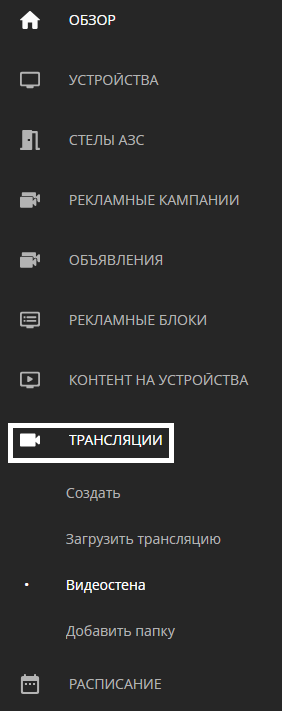
In this section, the user can create various types of broadcasts, configure broadcast parameters, and apply ready-made broadcasts to devices.
Starting Page
Upon navigating to the broadcast creation page in the personal account, the user will be presented with the main page of the section. This section can be divided into two areas:
- Broadcast search area
- List of broadcasts area
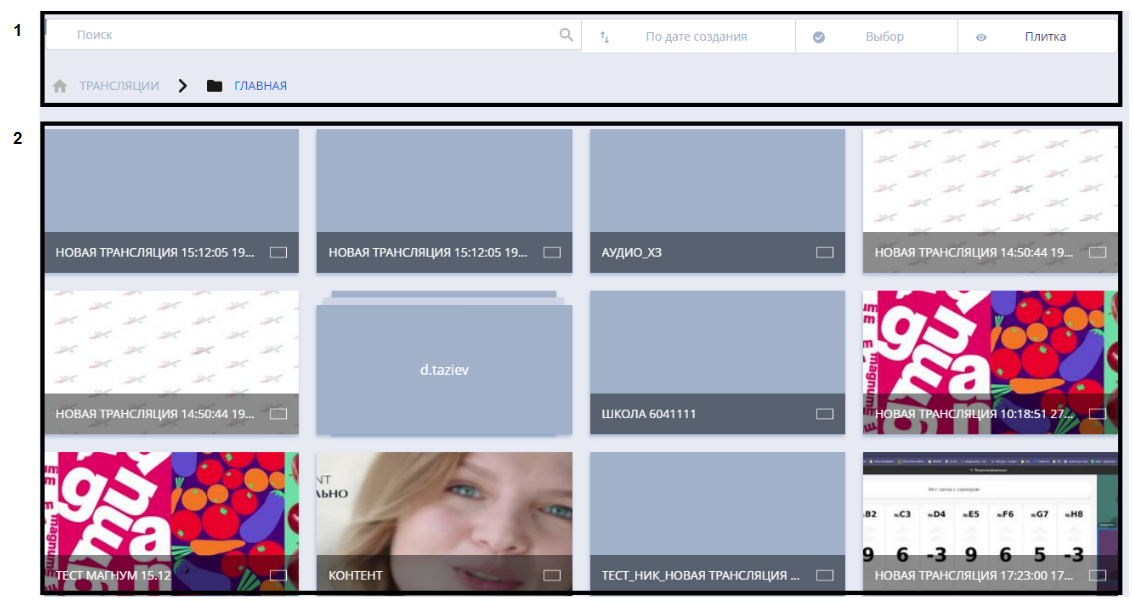
Search Area in the Broadcast Section
In this area, the user can change the display of ready-made broadcasts on the page.

The user has the following options available:
- Find a broadcast in the search bar
- Set sorting: by creation date or in alphabetical order
- The ability to select/deselect all broadcasts
- Change the display of broadcasts: in a grid or list format
Broadcast List Area
In the broadcast list area, users can view all the currently available broadcasts.

The list of these capabilities includes:
- Downloading a broadcast
- Cloning a broadcast (creating a duplicate of the current broadcast)
- Setting a schedule
- Editing the schedule (a settings list identical to the one used when creating a broadcast will open)
Deleting the schedule
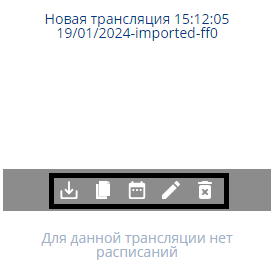
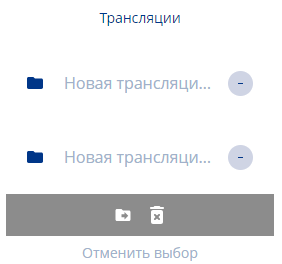
In this sidebar, users can interact with the following settings:
- Use the "-" icon to deselect the broadcast
- Move selected broadcasts to another folder using the folder icon with an arrow
- Delete selected broadcasts from the list of broadcasts
Categories of the "Broadcasts" Section
The "Broadcasts" section in the personal account is divided into four categories. These categories include:
- The ability to create a broadcast
- The ability to upload a broadcast
- The ability to use video wall mode
- The ability to add a folder
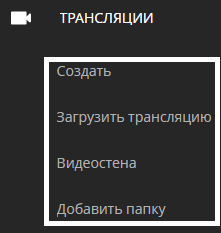
"Create Broadcast" Category
Upon entering the "Create Broadcast" category, the first thing users will see is a new window with a content area and the content itself.

This block can also be divided into several zones:
- Content work area
- Content search area
- Content area
Content Work Area
The content work area is quite extensive and difficult to consider as a single system. Therefore, it's better to divide it into categories.

The content work area consists of three categories:
- General broadcast settings
- Working with the content zone
- Working with the audio track
"General Broadcast Settings" Category
The general settings of the broadcast include information about the broadcast and several tabs. They can be opened by clicking on the content located in the broadcast zone. These details include:
- Broadcast title - the name of the current broadcast is indicated
- Broadcast settings - allows setting parameters such as: name, parent folder, specifying the width and height of the screen. To apply all settings, the "Save" button must be pressed.

Save settings - allows saving the current broadcast settings. Do not save and close the editor - allows closing the editor without making changes to the broadcast.

Content Zone Work
The "Working with the Content Zone" category involves adding and setting up content.
The entire category can be divided into three areas:
- Adding and settings for content - allows the following actions: move to the next/previous step, zoom in/out, stretch content to fill the zone while maintaining/proportionately or to any size while keeping proportions, view content animation settings, add a table.
- Content work area - the necessary content is added inside this area for the user. After adding content, double-clicking with the mouse can open additional settings for the content work area. In the opened settings, the following parameters can be set: a checkbox "Place content continuously over time", a checkbox "Loop mode for content in the zone", set the playback order, content name, start time of content, duration, layer level, frequency of appearance, left and right margins, width and height of content, transparency.

- Additional settings area - includes settings related to the timeline presentation mode (vertical, horizontal, and list), additional page settings (content duration in seconds and page volume level), and the ability to preview the broadcast.

Audio Track Work
The "Working with the Audio Track" category involves interactions with audio.

When working with audio, the following options are available:
- Listen to the audio itself
- Open sound track settings
- Clicking on the icon will open a window with settings parameters.
- Inside the parameters window, there are:
- Basic parameters - shows the number of audio tracks and technical information.

- Additional parameters - allows setting various audio parameters.
- Additional parameters are located to the right of the basic parameters and include three tabs:
In the audio track tab - you can change the volume for all content.

In the tab, all selected content will be presented. In the auto-positioning tab, the following parameters can be set:
- Write ad inserts
- Set the volume level for ad content
- Write background content
- Set the volume level for background content
- Set the playback order
- Configure and calculate with a checkbox the possibility of alternating ad content on a permanent basis or temporarily (in seconds).

Content Search Area
The content search area includes basic functionality for searching, sorting, and adding content.

The following settings are included in this area:
- Search - allows finding a file with the needed content.
- Change content display - changes the display from tile to list and back.
- Upload file - allows uploading a file with content.
- "Path" of content location - shows the "path" where all the content is stored.
Content Zone
The content zone includes several components.

These components include:
- Sorting by content type - allows selecting a specific type of content from those available.
- Available content types may include: all content, images, videos, music, documents, links, text, tables, widgets, content on a connected device.
- The ability to add a folder - allows adding a folder to the data storage.
- The ability to add a widget - the ability to add a widget from the list of widgets available on the account.
- The list of available content - presents a general list of available content. The display of content changes depending on the sorting settings described above.
"Upload Broadcast" Category
Clicking on the "Upload Broadcast" category will open the upload window. Through this window, the user can upload a broadcast.
The broadcast to be uploaded must be in an archive format. During the upload process, a new window will appear showing the upload progress.
After the upload is complete, the broadcast will appear in the list.

After uploading, the new broadcast will appear in the list.
"Video Wall Mode" Category
Clicking on the "Video Wall" category opens a new window. In this window, the user can configure broadcasts to work in video wall mode.
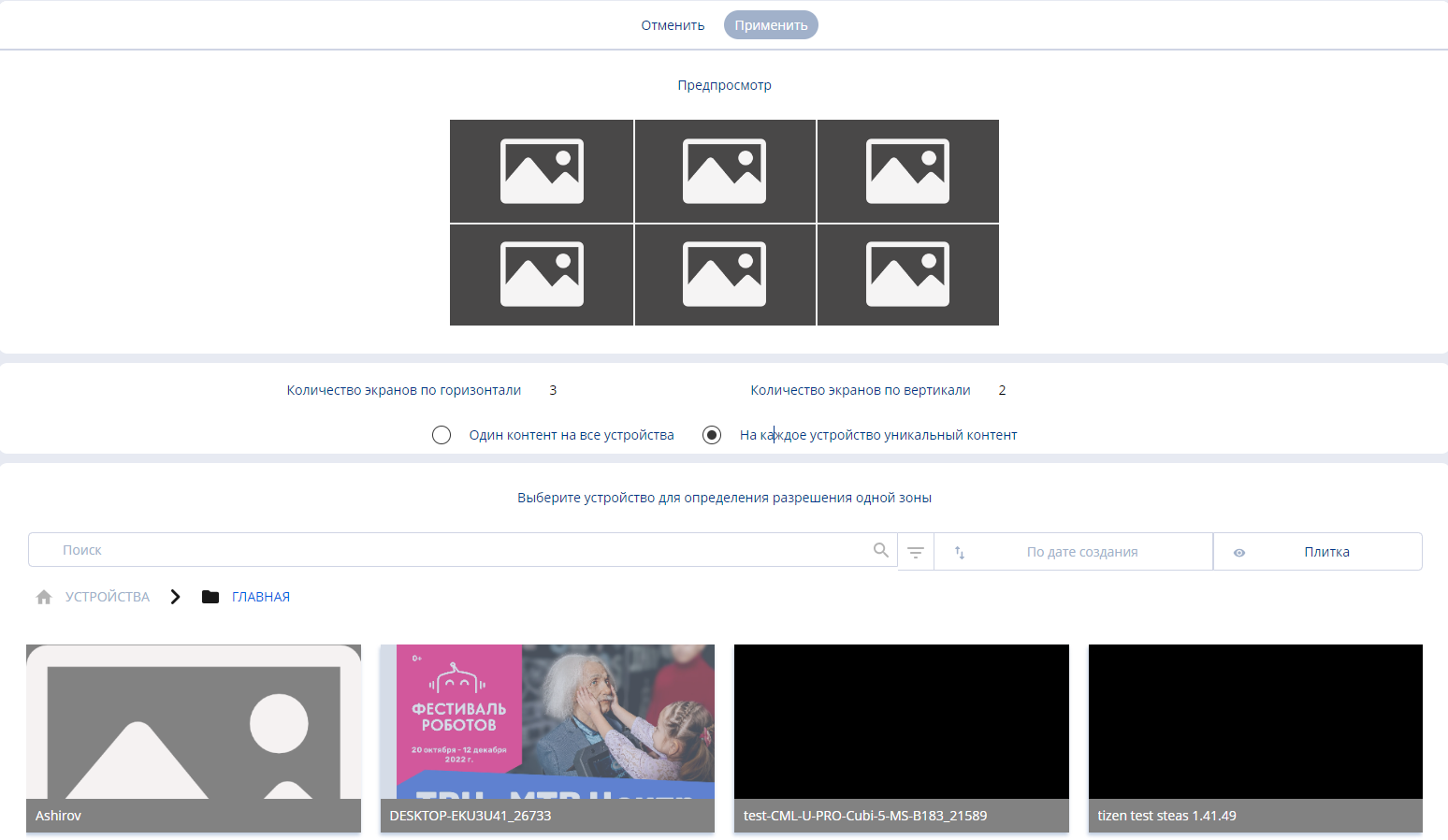
On the page, you can set the parameters necessary for the operation of the video wall mode.
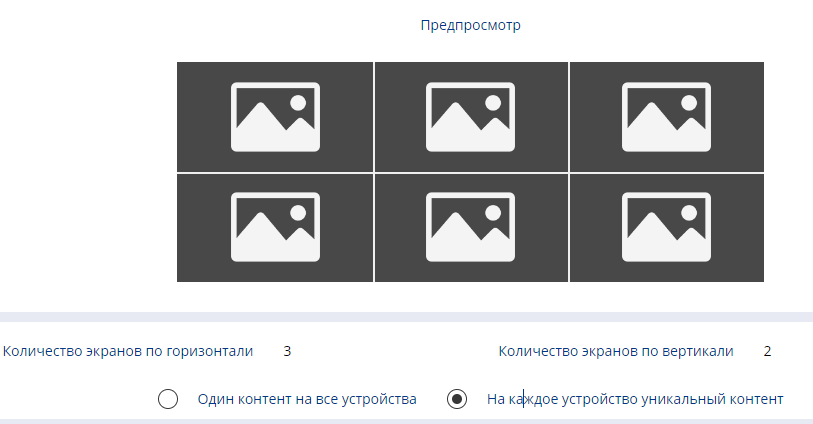
The list of parameters that need to be configured includes:
- The ability to view the content layout on devices
- Specify the number of screens horizontally (in units)
- Specify the number of screens vertically (in units)
- Choose the content display mode: one content for all devices or unique content for each device
Next, the user needs to select the necessary devices from the list at the bottom. The search bar, which works similarly to the search zone described at the beginning of the article, can help find specific devices. After setting all the parameters and selecting the required devices, the user needs to click the "Apply" button at the top. The system will show a pop-up message informing that the resolution for the video wall will be automatically selected with the size "3840"x"2160".

Next, the user will see a window with the content that needs to be placed on the video wall. The user must add the required content and configure both the page and the content zone similarly to the settings described in the "Create Broadcast" category.
"Add Folder" Category
Clicking on the "Create Folder" category allows the user to create a folder and assign it a name.
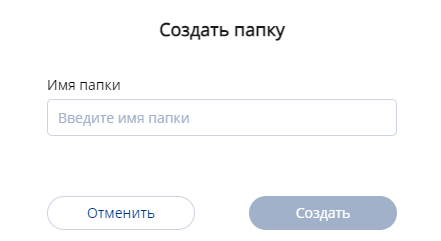
After assigning a name, the user needs to press the "Create" button.
Final Result
The user knows and can work with the broadcast section. At the same time, they understand the capabilities outlined in this section and know how to use them.